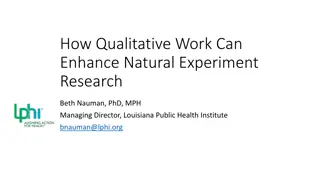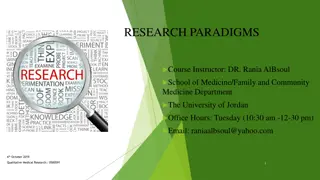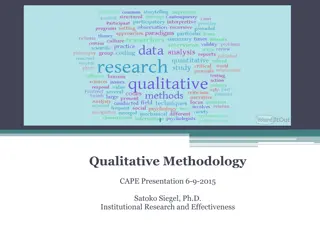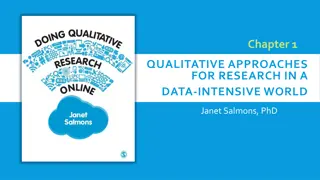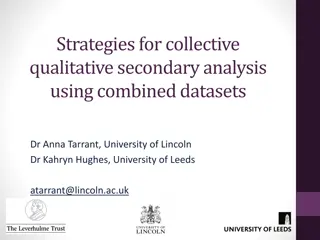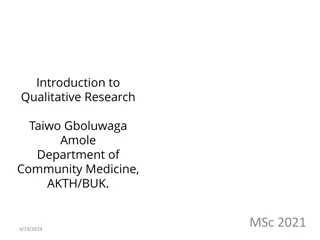Understanding Qualitative Research in Health Sciences
Qualitative research in health sciences offers a deep understanding of complex topics, giving voice to individuals and groups through non-numerical data analysis. Its flexible reporting style, emphasis on context, and ability to fill gaps in knowledge make it a valuable complement to quantitative methods. This method helps address gaps in understanding and provides a theoretical foundation for research.
Download Presentation

Please find below an Image/Link to download the presentation.
The content on the website is provided AS IS for your information and personal use only. It may not be sold, licensed, or shared on other websites without obtaining consent from the author. Download presentation by click this link. If you encounter any issues during the download, it is possible that the publisher has removed the file from their server.
E N D
Presentation Transcript
Qualitative Research in Health Sciences: Benefits, Approaches, Limitations, and Ethical Considerations Advanced Methods at Purdue (AMAP) Elizabeth Kielb & Carlyn Kimiecik February 3rd, 2023
Activity What is Qualitative research? The Why and When of Qualitative Research Approaches to Qualitative research Workshop Overview & Agenda **Break** Recruitment and ethical considerations Analytic approaches Data storage and resources Activity Conclusions
1. SHARE EXPERIENCES 2. UNIQUE PERSPECTIVES 3. LEARN TOGETHER Intention and Purpose 4. PRACTICE 5. DISCUSS
Activity: Brain Cloud What comes to mind when I say Qualitative Research? Qualitative Research is
Overview of Qualitative Research What is it, why is it important, and how to approach it
Broad Definition: Involves collecting and analyzing non-numerical data Purpose: gather in-depth insights into a problem or to generate new ideas for research Examples: Observations Recording what has been seen, heard or encountered in field notes Interviews One-on-one conversations with participants Focus groups Asking questions and generating discussion among a group of participants Surveys Using questionnaires with open-ended questions Secondary research Using existing data in the form of text, images, audio, video, etc. What is Qualitative Research?
The Why and When of Qualitative Research Complex understanding is needed A voice to individuals/groups Literary and flexible style of reporting is appropriate Understanding of contexts Follow-up explanation of mechanisms about quantitative findings Theory to address gaps in understandings (Creswell & Poth, 2018) Lack of fit for quantitative measures
Philosophical Assumptions and Interpretive Frameworks Beliefs about the nature of reality, what counts as knowledge and how knowledge claims are justified, the role of values in research, and the process of research. Postmodern Perspectives Post positivism Social Constructivism Critical, Race, Feminist, Queer, Disability Transformative/post modern Pragmatism
1. Narrative Research Qualitative Research Strategies and Approaches 2. Phenomenology 3. Grounded Theory 4. Ethnography 5. Case Study
Narrative Inquiry Narrative Inquiry Explore individual lived experiences Narrative Research Tell stories of lived experiences (Czarniawska, 2004; Pinnegar & Daynes, 2007)
Narrative Inquiry Narrative Inquiry Tell me a story about your experience individual, co-constructed, performed Captures complexity of lived experiences Detailed stories of a person or small groups of individuals Relational Types Collection Analysis Challenges Biographical study Autoethnography Life history Oral history Interviews Documents Pictures Thematic Performance Soft skills Willing to spend time Write, images, metaphors
Phenomenology Phenomenology Understand essence of lived experience Phenome- nological Research Describe a lived phenomeno n
Phenomenology Common meaning of lived experience of a concept Universal essence Collection Analysis Challenges In-depth multiple interviews Thematic Textural and structural descriptions Bracketing Researchers' understanding
Grounded Theory Grounded Theory Develop a theory from the data Grounded Theory Ground a theory in views of participants
Grounded Theory Unified theoretical explanation Moves beyond description to generate or discover theory for a process or action Collection Analysis Challenges Interviews Observations Documents Theoretical sampling Inductive Open, axial, selective coding Causal conditions Patterns Preconceptions of a theory? Saturation and sufficient detail (Corbin & Strauss, 2007)
Ethnography Ethnography Describe and interpret a culture- sharing group Ethnography Describe and interpret shared patterns
Ethnography Thick description obtained through an immersion in the everyday life of the group or a given social setting Interested in cultural concepts shared patterns Study meaning of the behavior, the language, and the interaction among members of the culture-sharing group Collection Analysis Challenges Fieldwork Interviews Surveys Spatial mapping Audiovisual methods Descriptions Theme analysis Emic (participants) Etic (researcher) Meaning of a social-cultural system Prolonged fieldwork
Case Study Case Study Description and analysis of a case(s) Case Study Provide an understandi ng of a case(s)
Case Study Develop an in-depth understanding of a complex phenomenon in its natural context by way of collecting data from multiple sources Individual, small group, organization Study of a bounded system (case) over time through detailed, in- depth data collection Collection Analysis Challenges Purposeful sampling Observations Interviews Documents Audiovisual Holistic analysis Embedded analysis Analysis of themes Case selection Setting bounds for cases (time, events, processes)
Take a Break We ll resume our presentation in approximately 10 minutes
Recruitment and Ethical Considerations
Consider the population you work with? Share with the group How much time is reasonable for this population? Recruitment Are you working with protected groups? Transportation and feasibility of one-on-one vs. group data collection Research questions Example: experiences of adults enrolled in a community wellness program What are the benefits of doing one-on-one interviews vs. focus groups for something like this? Setting In-person, Zoom, phone calls, etc. What setting are you interested in? Example: parent perceptions of mealtime interactions What are the benefits of Zoom or phone calls compared to in-person interviews or focus groups for this population and family-specific topic?
Recruitment How do you determine an appropriate sample size? What is the purpose of your qualitative study? Is this a stand-alone study or part of a larger multiple-methods study? For mixed-methods studies, or studies using deductive approaches: - May already have a pre-determined sample if part of a larger primarily quantitative study - Will a qualitative piece be required for participants? - Some participants may not be willing to take the time for qualitative research For stand-alone studies, or studies using inductive approaches: - Data saturation
Research Questions What is your topic? What is the age of your participants? Are you asking about sensitive or controversial topics (e.g., not socially accepted, illegal)? Example: experiences during pregnancy of carrying parents with substance use disorder Researcher bias Social desirability bias Ethical Considerations Deidentifying data Assigning IDs to any identifying information (e.g., participants, locations, groups) Full-face recordings Necessary to analyze some data (e.g., focus groups) Using HIPAA-compliant folders (available through Purdue Box) Audio recordings Can be a good option for one-on-one interviews, and is often exempt through the IRB Transcripts Replacing identifiers (e.g., names, dates, locations) with broad terms (e.g., [CHILD A], [FALL], [MIDWEST])
Analytic Approaches
Fig. 1 Example workflow for content and thematic analysis Where to Start Project workflow Example: Figure 1 What needs to be done? What protocols need to be made to answer your research questions? IRB, data collection, discussion guides or topics, data cleaning What data management and cleaning do you need to do before performing analysis? Example: do you need transcripts? Finish Start
What format is your raw data in? Common examples: Recordings (e.g., video or audio) Open-ended survey responses (e.g., text entry in Qualtrics) Data Cleaning and Management What format do you need the data to be in? Example of raw data: one-on-one phone interviews were collected with older adults, audio recordings Example of what you need it to be in: deidentified verbatim transcripts, word files How do we transform the data? ***Make protocols for each step*** Manual word-for-word transcriptions time intensive Software options can be expensive, but saves time Dedoose Ubiqus (formerly verbal ink)
Content Analysis Purpose: to describe and categorize words, phrases, or ideas in qualitative data Deductive analytic approach as close to hypothesis testing as qualitative research gets Operationalized based on previous findings in research, or existing theories Example: you are curious how often (frequencies) parents use math-related language while doing a simple task with their child What could this process look like from start to finish? Record parent-child task Transcribe all verbalizations from the task word-for-word (manually or using software e.g., Dedoose) Using search terms, or qualitative software (e.g., Nvivo, Atlas Ti) search and code/highlight pre-determined words and phrases Final data is in counts for specific words/phrases and by the participant
Thematic Analysis (Also referred to as textual or discourse analysis) Purpose: to explore in-depth themes, perceptions, and experiences Inducive analytic approach involves identifying patterns in responses among participant experiences or using broad concepts to uncover common trends in perceptions Example: you are curious about the perceived/actual barriers to utilizing benefits from supplemental nutrition programs What is this process from start to finish? Record one-on-one interviews with participants Transcribe the interview word-for-word Thoroughly review transcripts to identify common ideas, perceptions, and trends in responses Manually highlight or use qualitative software (e.g., Nvivo, Atlas Ti) to search and code/highlight commonly identified words and phrases Results typically rely on quotes from participants that discussed similar themes
Data Storage and Resources
Data Storage What needs to be stored? IRB documents, codebook/protocols, raw data, exported data, reliability check files, tech reports, references, etc. Primary files and backups Examples: Purdue Box Purdue University Research Repository (PURR) Qualitative pre-registration template now available on Open Science Framework (OSF, 2020) Does not require hypothesis testing Allows for transparency while identifying expectations that may influence analyses (e.g., predetermined codes, themes, etc.)
Resources Data Cleaning Dedoose Data Analysis Nvivo available for free on Purdue Community Hub Data Storage Box available to Purdue students Ubiquo PURR available to Purdue students Atlas ti OSF not exactly storage, but an organizational project tool
AMAP Approved: ANTH 592: Qualitative Data Management and Curation COM 585: Qualitative Methods COM 624: Focus Groups and Interviewing for Strategic Communication POL 608: (Mixed Methods) Field Research Methods POL 608: Qualitative Methods SOC 580: Research Methods (not Qual specific, but includes a lot of qual studies and information) SOC 686: Qualitative Methods SOC 681: Mixed Methods TECH 697: Qualitative Research Methods for Technology Studies Purdue Courses in Qualitative Methods
Due to its real-world nature, qualitative data can be unreliable with uncontrollable factors influencing the data Reliability Difficult to replicate, and interpretations of the same data may vary Subjectivity Considerations for Qualitative Research Smaller sample sizes may not be representative of an entire population; however, this does not mean that qualitative findings are not meaningful Limited generalizability Software is a helpful tool, but most qualitative analysis needs to be done manually Labor intensive
Activity: Lets Practice Partner Up What do you enjoy about your research? How do you know you like this? What is your favorite part about your research What is the most challenging aspect of your research Listen, probe, take notes, be curious Share with the larger group Were there common themes? What are they?
Acknowledgements Advisors Dr. Kameron Moding Dr. Yumary Ruiz Department of Human Development and Family Studies Department of Public Health Advanced Methods at Purdue
Thank You! Questions or Comments? Contact Us Elizabeth Kielb: ekielb@purdue.edu Carlyn Kimiecik: ckimieci@purdue.edu











